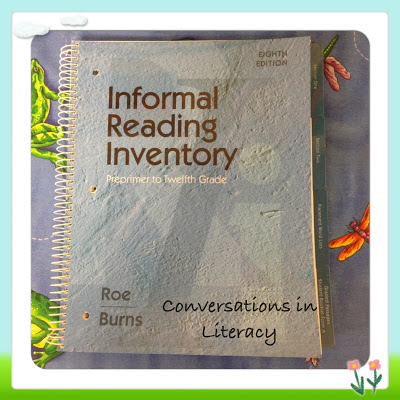We have now switched over to the IRI- Informal Reading Inventory. There are several different ones to choose from. This is the one we happen to use.
In grades K-3, we still have that focus on the students’ fluency. They must pass the oral fluency part of the DRA to be able to complete the remainder of the assessment. But once students get into older grades, the focus should be shifting more from the fluency to the comprehension. At our school, we have made a cut off of once they pass a DRA 38 (end of third grade) they then are assessed using the IRI. The IRI has a fluency component to it, but the students are not timed. If they pass the fluency part, they are then asked a series of comprehension questions ranging from main idea to inferencing to vocabulary.
IRI Reading Assessments
Last Wednesday I showed you what reading assessment we use for grades K-3. You can read about that DRA reading assessment post here.
We used to use the DRA 2 all the way through grade 5. And while I really like the DRA 2 and do believe it to be pretty accurate, it can be pretty time consuming for the older grades because all of the comprehension is written.
I took all of the IRI reading passages made copies and filed them into hanging files. This makes assessing so much easier to pull the level you need and the form you need. Each grade level has 4 different passages or forms to choose from.
This is an example of a grade 4 form B reading passage that a student would read. The passages that the student reads from are coded so that they do not know what grade level they are reading at.
As the student reads from their paper, the teacher has a page that looks like this. You basically do a running record on them and figure their score. If they pass, you ask the comprehension questions listed at the bottom. They even write in the answers for you! Students just answer out loud rather than writing all of their answers down like on the DRA. I must tell you that this has saved the upper level teachers and myself a huge chunk of time!! And don’t let the one page test fool you, it is not an easy test to pass. Some of the comprehension questions can be a bit difficult. I also like the fact that each question is coded to what type of question: inference, detail, sequence, etc… Then you can go back and analyze the tests to see what type of questions your class as a whole is low in.
Reading assessments are so important and can give you such important data. It is critical that we choose a good assessment and then use that data to drive our instruction. I have already had a teacher come down to get the scores for the students she may be getting next year. She wants to look over the data over the summer so she knows what her class is going to need right from the start!!! Yay!






I like your way of assessing. It seems like it gives you useful and accurate information.
❀ Tammy
Forever in First
Great post Lori! I love what you do for these kids. 🙂
Thanks Tammy! Both the DRA and the IRI do give you lots of good data!
Thank you Brandee! I appreciate your kind words!
Is there an easy way to translate IRI data for placement in scholastic guided reading levels?
Hi Janet! The way I use levels from Scholastic and other book levels is to use a book level correlation chart. You will have to do some professional guesstimate as none seem to fit together perfectly. We used the IRI for 4th grade and up. If a student passed an IRI level for 4th grade then we looked for books on 4th grade reading levels, which there are a few levels for that grade. Hope this helps you! 🙂